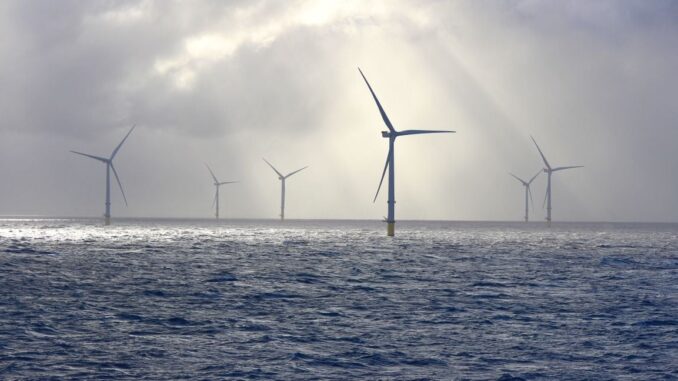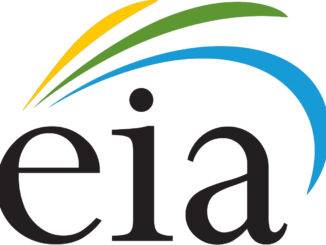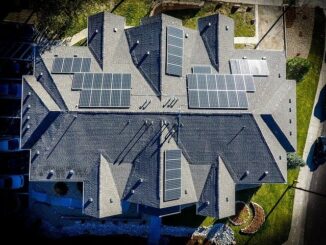
The lease sale drew lower bid prices than similar sales held on the East Coast – an outcome that experts say reflects the uncertainties faced by the industry.
The first offshore wind lease sale conducted by the Bureau of Ocean Energy Management in the Pacific Ocean drew lower bid prices than similar sales on the East Coast, and experts say the outcome reflects the uncertainties faced by the offshore wind industry in California, but could benefit ratepayers in the long run.
“[This] definitely was not the super competitive auction that I was expecting,” given the excitement over setting up a California offshore wind industry, ambitious offshore wind planning goals adopted by the state, as well as the drive to get a floating offshore wind sector set up in the United States, said Samantha Woodworth, senior research analyst with Wood Mackenzie.
The lease sale drew winning bids from five companies that amounted to $757.1 million, for five lease areas that cover more than 370,000 acres off the coasts of central and northern California. BOEM estimates the areas could generate some 4.6 GW of offshore wind energy. The winning bids, however, came in at an average of $2,028 per acre — lower than the $2,861 per acre average from the auction held in the Carolinas in May, and the $8,951 average that resulted from leases in New York and New Jersey in February.
Many project developers realize that global supply chain issues and high inflation trends aren’t easing soon, making some wary of committing to massive investments, she said.
“Lower bid prices are a way of penny-pinching where developers can. And also, I think a lot of developers are [thinking] it’s kind of a weird time right now — let’s proceed with caution, let’s take it easy,” Woodworth said.
But those lower bid prices could have an advantage — they translate to less upfront costs for developers, which, in turn, could translate to lower power purchase prices for offshore wind that ultimately flow through to the electricity rates of consumers, as well as allow leaseholders to make investments in building an offshore wind supply chain in California.
“So not only does it behoove the industry to keep those bid prices low, because it keeps their overall project costs down — but it also increases their probability of getting [the projects] approved by the powers that be, by the utility commissions [and] the state,” Woodworth said.
Now, industry advocates say, California needs to work on creating a plan for permitting offshore wind projects, developing ports that can bolster the new industry and figuring out what transmission it needs to bring offshore wind energy on shore.
Lease sale results: some surprises, some encouraging trends
BOEM’s California lease sale reflects “a significant milestone” toward the Biden administration’s goal of installing 30 GW of offshore wind capacity in the U.S. by 2030, and 15 GW of floating offshore wind specifically by 2035, the bureau said in a statement announcing the results of the lease sale. Five companies were named provisional winners of the auction: RWE Offshore Wind Holdings, California North Floating, Equinor Wind US, Central California Offshore Wind and Invenergy California Offshore.
The U.S. West Coast is “one of the most attractive growth regions for floating offshore wind in the world due to its favorable wind conditions and proximity to markets that need reliable, clean energy,” Equinor Wind US President Molly Morris said in a statement. Equinor secured a roughly 2 GW lease in the Morro Bay area, off the central California coast that spans more than 80 acres. The company operates two other lease areas, Empire Wind and Beacon Wind, off the Northeast coast.
“We don’t have enough investments in ports, we don’t have a clear offtake plan and we do not have transmission plans to the North Coast, at least.”
Nancy Rader
Executive Director, California Wind Energy Association
For the industry, the lease sale results included some surprising outcomes and encouraging trends, according to Sam Salustro, vice president of strategic communications with The Business Network for Offshore Wind. Bid prices were lower than the East Coast, but indicate confidence in a new market that doesn’t have a very visible path to offtake agreements and still needs to build ports and develop a supply chain and workforce, according to Salustro.
The surprising part, according to Salustro, was that the auction had only seven bidders, when 43 bidders were pre-qualified. These seven were largely developers who are already active in the U.S. market.
“I think that’s surprising because there are a lot of floating [offshore wind] developers globally and we may have thought that… some of them may have gotten involved. But they stayed out and it was people already in the American market who won the leases — which sort of signals that while there is a lot of confidence in the American market, the people who have the most confidence are the ones who are actively engaged with it,” he said.
Salustro and other experts aren’t surprised the bid prices were lower than those seen this year in the New York Bight, which drew winning bids of about $4.4 billion from six companies.
“That was a perfect storm, because they had the ports, they have a supply chain, they have an offtake, they have a workforce that’s developing — we’re probably not going to see those prices again for a long time here in the American market,” he said.
Nancy Rader, executive director of the California Wind Energy Association, also believes the results of the auction reflect California’s lack of a clearly charted out path to set up this new offshore wind industry, which translates to creating more risk for developers and lower lease bids.
“We don’t have enough investments in ports, we don’t have a clear offtake plan and we do not have transmission plans to the North Coast, at least,” she said.
In fact, California’s offshore wind industry still does not have much certainty on what the final offtake agreements for offshore wind will look like. These projects are large in scale, and it can be difficult for some load-serving entities — like smaller community choice aggregators — to procure power from them, said Michelle Solomon, policy analyst at Energy Innovation.
One way experts say the state can get around that is by creating a central procurement agency to procure the energy and sell it to smaller entities, according to Solomon.
Another point of uncertainty for the industry is that California is trying to set up a relatively new technology — floating offshore wind. The East Coast has shallower waters, so projects can have fixed-bottom turbines that are prevalent around the world. California’s waters are much deeper, so the wind turbines will need to be floating and tethered to the bottom of the ocean using cables. Floating turbines are a mature technology for depths of a few hundred meters — but California’s water depths, in the area of the lease sales, are more like 800 meters to 1,000 meters deep, she added.
“There’s just more to be done to get the industry up and running in California… so [it’s] not surprising that the lease sale is a little bit less than New York. I would say this is still a high total,” Solomon said.
The lower bid prices have an ancillary benefit, said Rader. Astronomical bid prices on the East Coast run the risk of pushing up power purchase prices, she said. Moreover, this money goes to the federal government instead of meeting the infrastructure needs, such as transmission and building ports, in which California needs to invest.
“So in that sense, it’s good that the bid prices are lower, because it will affect power purchase prices to a lesser extent,” she said.
Going forward: ports, transmission and more call areas
Offshore wind can play a critical role in California’s energy mix as the state transitions to a decarbonized grid. The state has relied heavily on solar power to provide renewable energy, whether on rooftops or large-scale solar arrays. Wind can complement solar power as it kicks in when the sun goes down, said Laura Deehan, state director of Environment California.
This August, California regulators adopted offshore wind planning goals for the state of 2 GW to 5 GW by the end of the decade, and 25 GW by 2045. Those goals provide a critical boost to the industry, experts say.
“Our whole thinking was we wanted to show investors and the energy industry, the folks who are building offshore wind in other parts of the world… that California is really serious about going big on offshore wind,” Deehan said.
“The state, as you know, has set a goal for 25 GW by 2045, so we need more call areas to enable us to achieve that goal.”
Adam Stern
Executive Director, Offshore Wind California
Looking to the next 10 years, California will need to create a clear roadmap for permitting offshore wind projects, a strategy to develop ports that can deploy and service offshore wind, a plan to site, permit and construct transmission, and a procurement policy for the offshore wind itself, according to Adam Stern, executive director of Offshore Wind California.
“And we need additional call areas,” he said. “It was terrific that this auction was as successful as it was, but according to BOEM, the combined capacity of the areas [is] 4.6 GW. The state, as you know, has set a goal for 25 GW by 2045, so we need more call areas to enable us to achieve that goal,” he said.
For developers, meanwhile, the next steps are to start working with the communities that will be affected by offshore wind energy development to figure out what kind of community benefit packages they can assemble, said Solomon. Developers may not have all the permits ready to start building in a leased area, and will need to focus on construction operation plans that comply with environmental considerations.
On the regulatory side, the California Public Utilities Commission needs to see how offshore wind fits into its long-term planning and require offshore wind energy to be procured, preferably by a central procurement entity, according to CalWEA’s Rader.
There’s still a long road ahead before wind turbines off the coast of California are producing energy, according to experts.
“A big issue in our view is are we going to get any of the economic benefits from this thing? Are we going to build any of this stuff in California?” Rader said. “We’re working very hard to make sure that we’re building at least some of the floating platforms in California. That’s the biggest ticket item that we can most likely capture.”
However, the state currently doesn’t have adequate port space to build these platforms, which can be the size of football fields, Rader said. “
“That’s a challenge — and if we can’t figure out a way to build out the ports… we won’t get many of these economic benefits,” she said.
Environmental impacts present another challenge to setting up floating turbines, according to Julia de Lamare, clean energy advocate with the Natural Resources Defense Council.
“Floating turbines are a new technology that has never been tested in the United States, which means the impacts on marine life, fisheries, Indigenous people, among others are unknown,” she said in an email.
Regulators must advance environmentally responsible offshore wind development, de Lamare said. She suggested requesting leaseholders to commit to avoiding and minimizing environmental impacts and conducting additional research to fill in data gaps.



